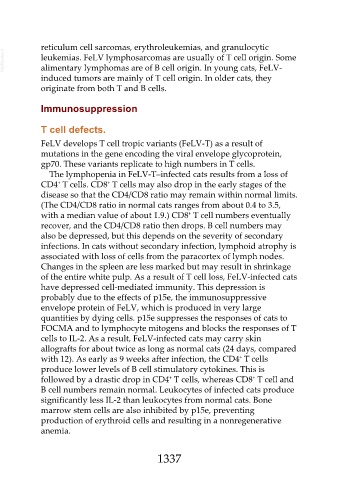Page 1337 - Veterinary Immunology, 10th Edition
P. 1337
reticulum cell sarcomas, erythroleukemias, and granulocytic
VetBooks.ir leukemias. FeLV lymphosarcomas are usually of T cell origin. Some
alimentary lymphomas are of B cell origin. In young cats, FeLV-
induced tumors are mainly of T cell origin. In older cats, they
originate from both T and B cells.
Immunosuppression
T cell defects.
FeLV develops T cell tropic variants (FeLV-T) as a result of
mutations in the gene encoding the viral envelope glycoprotein,
gp70. These variants replicate to high numbers in T cells.
The lymphopenia in FeLV-T–infected cats results from a loss of
+
CD4 T cells. CD8 T cells may also drop in the early stages of the
+
disease so that the CD4/CD8 ratio may remain within normal limits.
(The CD4/CD8 ratio in normal cats ranges from about 0.4 to 3.5,
with a median value of about 1.9.) CD8 T cell numbers eventually
+
recover, and the CD4/CD8 ratio then drops. B cell numbers may
also be depressed, but this depends on the severity of secondary
infections. In cats without secondary infection, lymphoid atrophy is
associated with loss of cells from the paracortex of lymph nodes.
Changes in the spleen are less marked but may result in shrinkage
of the entire white pulp. As a result of T cell loss, FeLV-infected cats
have depressed cell-mediated immunity. This depression is
probably due to the effects of p15e, the immunosuppressive
envelope protein of FeLV, which is produced in very large
quantities by dying cells. p15e suppresses the responses of cats to
FOCMA and to lymphocyte mitogens and blocks the responses of T
cells to IL-2. As a result, FeLV-infected cats may carry skin
allografts for about twice as long as normal cats (24 days, compared
+
with 12). As early as 9 weeks after infection, the CD4 T cells
produce lower levels of B cell stimulatory cytokines. This is
+
+
followed by a drastic drop in CD4 T cells, whereas CD8 T cell and
B cell numbers remain normal. Leukocytes of infected cats produce
significantly less IL-2 than leukocytes from normal cats. Bone
marrow stem cells are also inhibited by p15e, preventing
production of erythroid cells and resulting in a nonregenerative
anemia.
1337

